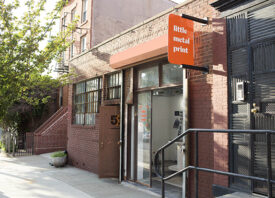Search this site
Dye Sublimation Printing and the Future of Fine Art Image-Making

Work by Lissa Rivera
Since its inception in 2005, Ken Allen Studios in Brooklyn has been a pioneer in the field of digital printing, carrying its founder’s decades of experience and knowledge of photo history into the modern age. As a trusted printer for leading photographers and institutions, including the nearby Guggenheim Museum, New York Public Library, and the Brooklyn Museum of Art, Ken Allen is constantly innovating and researching the next big thing in the business. Most recently, the studio welcomed a brand new dye sublimation printing facility into the fold.
All of the images featured in the Second Annual Feature Shoot Emerging Photography Awards Exhibition at United Photo Industries were printed using the cutting-edge process, which Ken Allen held off on introducing until he was certain it was the path of the future of fine art image-making. We interviewed Allen about the facility to learn what intrigues him about the process and its possibilities for exhibition and conservation.
Our show at United Photo Industries is on view until June 25th, 2016.
Can you tell us a bit how you came to incorporate dye sublimation?
“We are always researching improvements in the field of printing, and we keep a direct line of communication open with the manufactures and dealers. We also visit print shops around the world to see what other printers in other communities are doing. I had seen early samples of dye sublimation printing on a no name aluminum, and was not impressed. But then in the last year, we visited a printer in Austria (Salon Iris), and they had a new set-up using dye sublimation printing with Chromaluxe® aluminum, and the quality was impressive. After considering other print technologies like UV Curable printing, which would allow us to print much larger format on a wide variety of materials, I opted to move forward with the higher quality dye sublimation on Chromaluxe® process. Because a very large and expensive heat press is required for the process, it took some time to acquire the space and equipment to start up the process.”

Work by Lissa Rivera, Kimberly Witham
Why does it appeal to artists? What artists are using it or have used it to print work?
“The dye sublimation on Chromaluxe® has amazing depth and clarity. It has that dimensional effect that so many are striving for. Although we did not print the exhibit, Cindy Sherman has moved to the process and shows of current work like the one currently at Metro Pictures gallery in Chelsea are printed with the dye sublimation onto Chromaluxe® aluminum. You’ll have to travel to Arles France to visit the new LUMA museum to see our recent dye sublimation prints for Collier Schorr.”

Work by Lissa Rivera, Mariya Kozhanova
What separates dye sublimation from other printing methods?
“The process has more steps. First we print on a reversed image on transfer paper, then we attach the paper to a Chromaluxe® aluminum plate, and finally we load it into a large heat press where it is pressed at 400 degrees F for two minutes at 80psi of pressure. The transfer paper is then discarded and the dyes have been sublimated into the patented and durable coating on the aluminum.”

Work by Mariya Kozhanova
What are some of the advantages to dye sublimation printing?
“Besides the image quality, the amazing characteristic is its durability. We have to handle paper prints with kid gloves, and if there is a lot of black on a paper print, the odds of getting scuffed are high. The Chromaluxe® aluminum prints can be handled normally, and if they get fingerprints, it’s easy to wash them off with mild soap and water.”

Work by Camille Michel, Kimberly Witham
How do dye sublimation prints hold up over time?
“An independent study is being carried out by Wilhelm Imaging Research (and probably others too) concerning the light fastness and durability of the dye sublimation prints. The final results are not out yet; the studios take a while. But preliminary results are indicating that the dye sublimation on Chromaluxe® aluminum can be on display for 50 years before showing signs of fading. The biggest advantage of the Chromaluxe aluminum prints is the durability. Photo conservators did a study of museum photographic collections and found that the number one condition issue was print scratches, scuffs and bent paper. The Chromaluxe® aluminum print is the most resistant to these issues of any of the current high quality printing methods.”

Work by Marlena Waldthausen
What excites you about the advances the method has made over the past decade since it was introduced?
“The new F series printers released by Epson and the invention of the Chromaluxe® coated material are the key advancements that make this process such a great fit for fine art photography.”

Work by Kimberly Witham, Marlena Waldthausen
What hopes and expectations do you have for the new facility? What role will it fill within Ken Allen Studios?
“We are always seeking to create the perfect print, but this at times can be costly. It’s counterintuitive because the base prices of the dye sublimation printing is greater than paper prints, but as we work on exhibits, we are spending less time testing and redoing. Without the usual paper problems, we are often saving time on mounting and framing. I believe that we have some improvements in print quality, and we will also have the possibility of decreasing the total cost for photographers and artists. This excites us because it means people will be able to print more.”

Work by Kimberly Witham, Marlena Waldthausen
All images © Lissa Rivera



